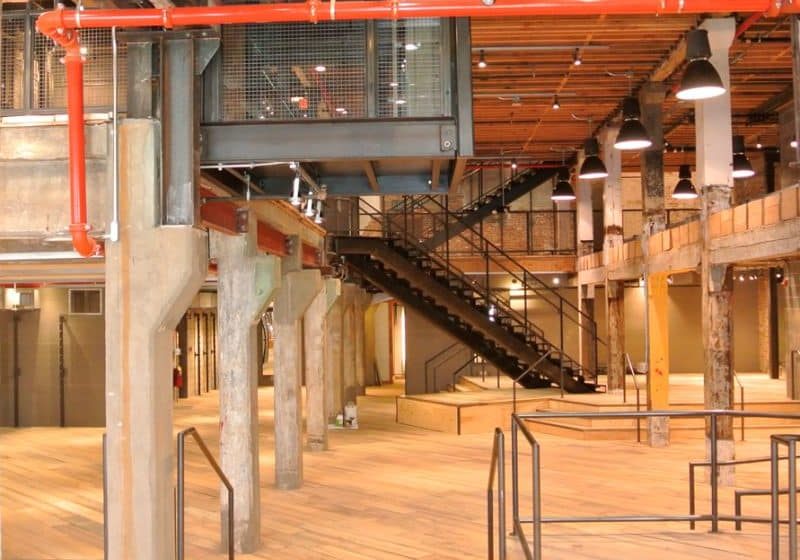Mad Men Elevators: The Top Five Scenes
Jun 1, 2015

Vertical transportation serves as a backdrop to subtle and not-so-subtle discussions on race, gender and human relations.
By the time this top-five list reaches you, it may already be obsolete. Seven episodes of the hit AMC television show Mad Men, the second half of the seventh and final season, began airing on April 5 and ran into May. As of this writing, there have been more elevator scenes, though none cracking the top five. But there might be one before the series is through.
Mad Men is the greatest work of elevator art ever, in all media, but why should the elevator industry care? Because culture drives demand. What we see on television and in the movies helps us imagine a world in which we might like to live; a world with a black president; a world where young girls grow up to be crime scene investigators; a world where we all leave the suburbs and move back to a city, creating a new wave of demand for elevator sales, installations and service. Car shows sell cars. Do elevator shows sell elevators? Could they?
If Mad Men is the greatest work of elevator art ever, that cannot be demonstrated in an article. One would need to say something more about all the other elevator art in the world and why it is inferior. But, one can demonstrate that Mad Men has an awful lot of interesting elevator scenes. In the first six seasons, I count 69 scenes in, near or about elevators.
In the first three seasons, elevator scenes shock us and call attention to themselves, especially when taking on big questions about gender, race and power.
That’s an average of 11-1/2 elevator scenes for each 13-episode season. Sometimes, they come two or three an episode, and their numbers nearly double in the later seasons, from eight in each of the first seasons, to the fourth (13 elevator scenes), fifth (17) and sixth (15) seasons. The epic opener of season six has five elevator scenes.
As elevators become more prevalent, they also become less prominent. In the first three seasons, elevator scenes shock us and call attention to themselves, especially when taking on big questions about gender, race and power. The scenes noisily echo each other to call attention to differences among white men like Don and Peter and the ways they treat white women like Peggy and Joan. They even show us a few minor black characters, most prominently Hollis the elevator operator.
In seasons four, five and six, scenes of crude sexual harassment give way to more subtle explorations of women’s limited opportunities in marriage and on the job. They echo each other to show differences among ways to be white women. Race relations do not drop out of the show, but they disappear from the elevators. The members of Sterling Cooper form a new firm and move to offices in a building without elevator operators.
In the fourth season, Peggy and Joan explore different ways to get ahead in a man’s world, and Megan joins this symbolic terrain in the fifth season. The sixth introduces the elevator as a significant space in Don’s affair with a neighbor. Usually more subtle and quiet than elevator scenes from the first three seasons, they show a turn to lyricism.
One theme that runs across all six seasons is the competitive spirit among young ad men. We see this in their shared sexual harassment of women, their weird détentes and awkward moments, their forced conviviality and episodes of hatred.
I have not included season seven in the stats because, as of this writing, the season was not yet complete, but I could not resist including in my top five one scene from the first half of season seven. Here’s the list so far.
5: Hollis the Focus Group
Season One, Episode Seven, 28:25
For three seasons, Don and the gang work in a building that hires black men to operate push-button elevators. This is historically accurate; the 1960s was a period of transition to fully automated elevator service. We get to know only one of these men by name. In his first appearance, (season one, episode three, 2:00), Hollis is played by a different actor. But, starting with the seventh episode of the first season, La Monde Byrd takes over the role and gives an understated performance that unfolds with each additional scene. Byrd’s first scene is still my favorite, though. It follows from the very first scene of the series, when Don does some impromptu consumer research with a black waiter at a bar, and informs the scene in the fifth episode of the third season (39:10), when Pete also tries to use Hollis for consumer research but goes about it all wrong. In the ninth episode of season two (1:58), Hollis remarks on the passing of Marilyn Monroe, “Some people just hide in plain sight.” The same could be said of Hollis.
4: Tableau of Working Women
Season Four, Episode Nine, 45:27
How to be a working woman in the 1960s ad industry? In the fourth and fifth seasons, Peggy and Joan continue to stake out different strategies, with Dr. Faye Miller and Megan offering further contrast. The most incisive elevator scene in this period (season four, episode eight, 35:53) is the dressing-down that Joan gives Peggy for bad strategy – firing a sexist, insubordinate illustrator rather than dealing with him in a more subtle and fruitful (feminine?) way. But my favorite scene from this period silently compares Joan, Peggy and Dr. Miller, the consulting psychologist who works with and dates Don in the fourth season. Joan and Faye enter an elevator and hold it for Peggy, and the three stand in a tableau of choices in a sexist workplace as the doors close.
3: Sally Fears an Elevator
Season Seven, Episode Two, 18:24
In the sixth season, Don begins his affair with downstairs neighbor Sylvia Rosen. The elevator figures in a number of ways, but the most moving scene about it is not in it. I don’t want to say any more. You’ll just have to watch the sixth and seventh seasons if you haven’t done so already.
2: Broken Elevator
Season One, Episode Seven, 40:32
This is the second scene from season one, episode seven, to break into the top five! The broken elevator is, of course, a common motif in elevator films and television shows, and a particular challenge to keep fresh. Mad Men does it twice. The first is the better one – a story of victory in Don’s battle with Roger for greater manhood. After an epic lunch of taunting each other into eating more oysters and drinking more liquor, they return to find Hollis standing in the lobby with an out-of-order sign. They have a meeting with Nixon’s people, so they taunt each other up the stairs, too, and then Roger vomits all over the carpet. In season five, episode seven (31:55), Don decides to follow Megan out of the building, but when the elevator doors open for him, there is only an empty shaft.
1: Take off Your Hat
Season Two, Episode One, 40:22
This is an even more common motif in elevator films and television – sexual harassment in the elevator. In the very first episode, Mad Men offers an homage to the ass-pinching scene in the classic movie The Apartment. In an early script, it even included an ass pinching of its own. In this scene, the characters are flat, both because the writing improved after the pilot and because we don’t know them yet. By the first episode of the second season, though, we can see paternalism, hypocrisy, displacement and a sincere desire to be better to women in Don’s elevator chivalry. With all these great elevator scenes, does Mad Men help the elevator industry? Probably not on its own. But constant repetition across mass media drives sales of other products, even some not sold directly to consumers (like ads for weapons systems on the Washington, D.C., metro). How can the elevator industry harness shows like Mad Men? How can ever-more-effective PR be dropped into next year’s elevator scenes? I don’t know, but I’ll keep thinking about it.
Get more of Elevator World. Sign up for our free e-newsletter.









